Create as many freezers in the application as you have physical storage locations. Customize the storage layout, aka
hierarchy, within each digital freezer to match the physical storage options available to your users. This topic describes how to define a new freezer from scratch. Once you have created a freezer, you may
copy it to create additional similar freezers. Users must have either the
Storage Designer or Administrator role to create and edit freezer layouts.
Create a Freezer
To create a new freezer, click
Storage on the main menu, then click
Create New Freezer. When creating your first freezer, you'll have an option to
Create a freezer on the main menu.

To create additional freezers, again click
Create New Freezer from the
Storage Dashboard or you may
copy an existing freezer.
Freezer Properties
Under
General Properties define the following:
- Name: Any string name that will clearly identify the physical freezer; it must be unique in the system.
- Label: Optional text description that will be shown with the name to help users.
- Manufacturer: Optional string for the company name or maker of this freezer.
- Freezer Model: Optional string for the manufacturer-assigned model number or name.
- Temperature: Optionally include the set-point or consistent operating temperature of this freezer when in use. When giving a temperature, specify Celsius or Fahrenheit.
- Freezer Location: If any freezer locations have been configured, you can specify here where to find this freezer.
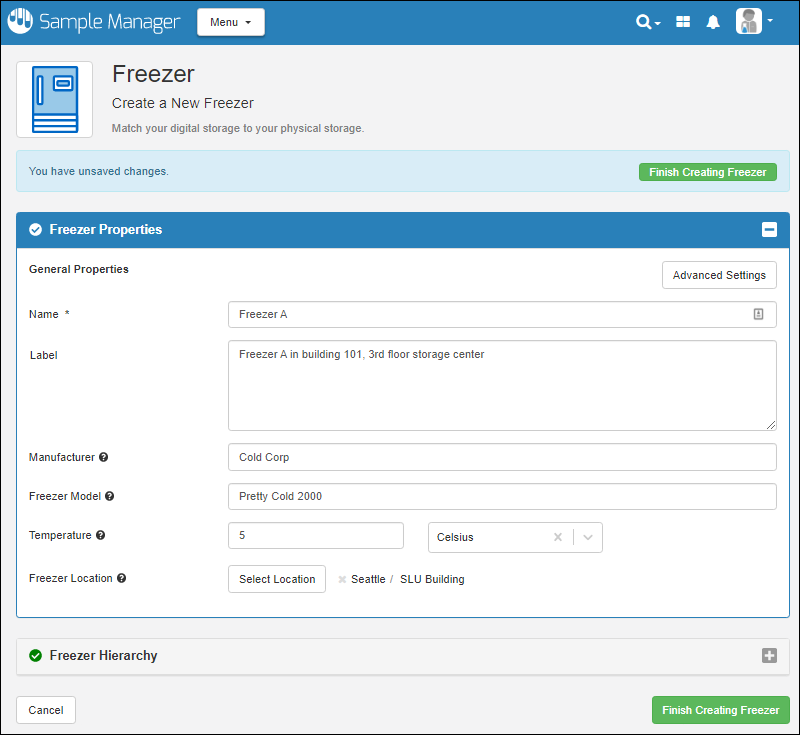
Continue to define additional properties if needed and describe the structure of this freezer in the
Freezer Hierarchy section before clicking
Finish Creating Freezer. You can also return to
edit this freezer after saving if you need to make changes to the properties later.
Advanced Freezer Settings
Click
Advanced Settings to set the following properties for this freezer. Click
Apply to save any changes.
- Serial Number: Unique identifier for this unit that can be useful for troubleshooting with the manufacturer.
- Sensor Name: If this freezer is using an alarm or monitor, you can provide the name here.
- Loss Rate: Indicates the time needed or rate at which the unit will return to an ambient temperature from its set-point.
- Status: Used to indicate if the unit is storing samples, available as a backup, or defrosting as part of a maintenance routine. Options:

Freezer Hierarchy
Click the
Freezer Hierarchy section to open it. Add the specific
Storage Units available in your physical freezer to the panel on the right, either by:
- Individually dragging them to the proper location in the hierarchy.
- Using Bulk Add to add many storage units at once.
There are two categories of storage unit available:
- Non-Terminal Storage Units : These units can be contained within each other in any combination, but cannot directly contain samples. For example, a shelf can have a rack which has 2 shelves, but there must be a bag, box, or plate on those inner shelves to contain the samples themselves.
- Terminal Storage Units: These units can directly contain samples and cannot contain other units. Note that these units will only appear in the hierarchy interface when one or more types or sizes have been defined.
- Bag
- Box
- Cane
- Plate
- Tube Rack
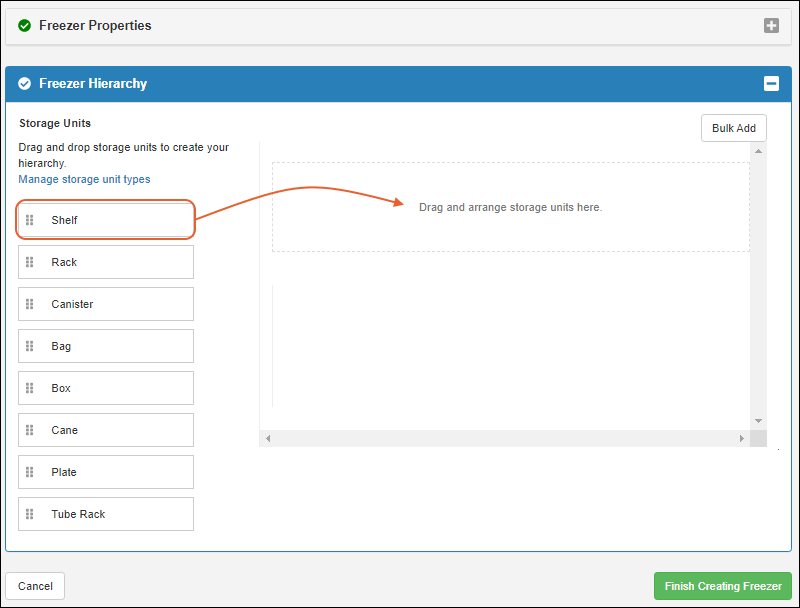
The system includes several built-in types (sizes/layouts), of each kind of terminal storage unit. You can customize the available terminal storage unit selections or add new ones by clicking
Manage storage unit types. Note that your work in progress creating this freezer will be lost if you click away now. Consider saving your work and returning to
edit the freezer definition when you have refined the options available.
Add each storage unit, customizing the default
short name if you like, and optionally adding a more descriptive
label.

Start with the "large" containment in your freezer, then drop structure within that container directly on top in the panel to place it "within" the container. Drag to rearrange them to match the physical freezer. For example, in this image there are three shelves, and to describe several racks on one shelf, we drop the first rack directly "on" the shelf. If we put it "next to" the shelf, it would be added as a separate rack at the same level as that shelf instead of "within" it.
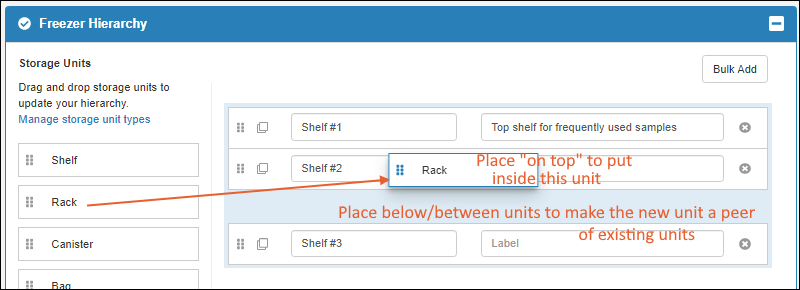
Click the
icon to collapse the display of any nested units - it will become a
you can use to expand the display again. To speed creation of repetitive hierarchies, you can use either:
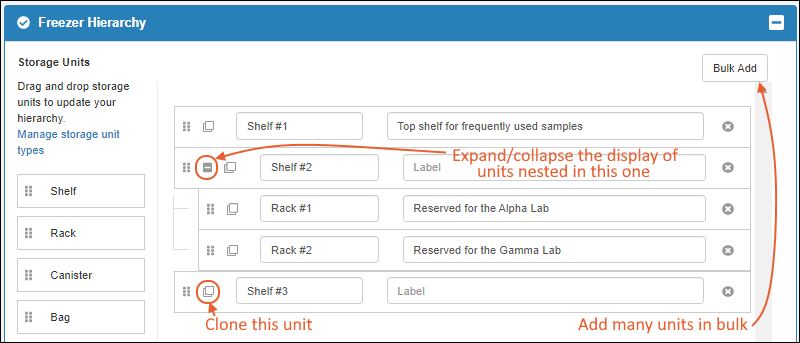
Continue to add the structures and terminal storage units that will contain your samples. For each terminal storage unit, you also specify the type (size/layout) of the unit.
- Bag: Select bag type from the dropdown.
- Box: Select box type from the dropdown.
- Cane: Select cane type from the dropdown.
- Plate: Select plate type from the dropdown.
- Tube Rack: Select the type of tube rack from the dropdown.
Storage Unit Names
By default, all the storage units you add will be named in a sequential numbering scheme, including the type of storage unit in this name. You can edit these names in any way will help your users find the correct locations, such as position/color/identifying labels you have applied or calling racks "partitions" if that is how your users refer to them. Unit names must be unique at any given level in the hierarchy. It is good practice to use unique names throughout the freezer to avoid confusion, particularly where there are many similar structures within your freezer.
Storage Description Labels
You can include a more verbose descriptive
Label for every level of your freezer hierarchy. When present, labels will be shown in many places to help users better identify the specific storage unit. Both as additional text in hierarchy listings, and as hover text when viewing storage location 'pathways' throughout the application
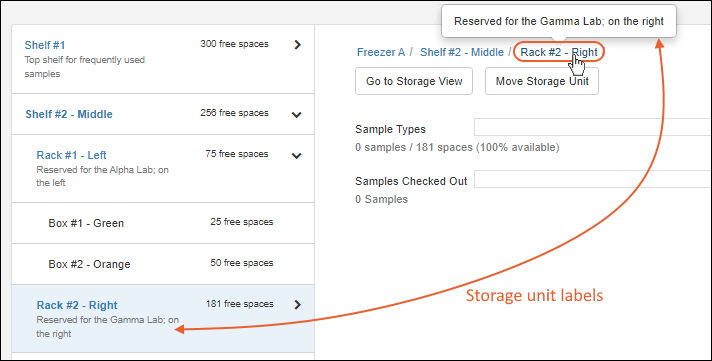
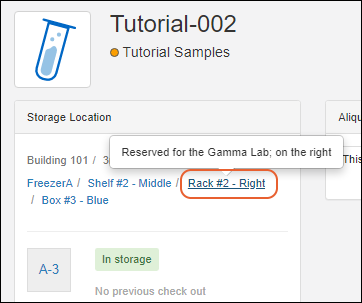
You can add new labels to existing units, or edit labels to update them, either by returning to
edit the freezer definition via this interface, or directly
edit them in the storage view for the unit using the
icon.

Clone Units
If you click
, you can clone a unit that contains other nested units. The entire structure will be cloned at the same level as the parent. This can speed the process of describing a repetitive freezer hierarchy.
Finish Describing Hierarchy
Continue to add elements and rearrange them to describe your storage. Here, there are three shelves. One of the shelves has 2 bags, another shelf has two racks, each with 2 boxes of different sizes.
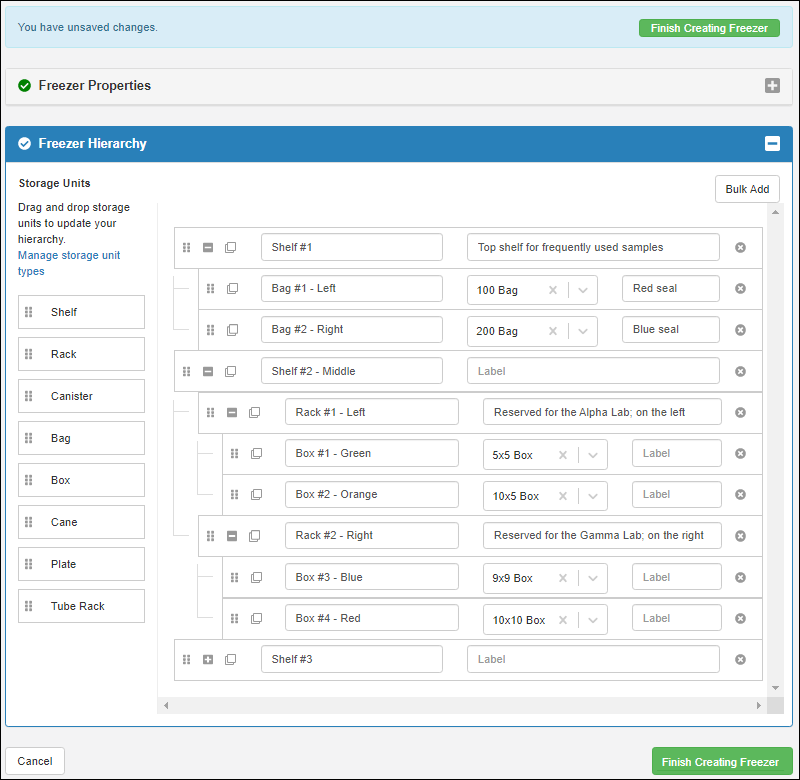
- Once you have completed your storage hierarchy, click Finish Creating Freezer.
- Note that you can return to edit your freezer hierarchy later, such as after defining new storage units.
- If any storage names are duplicates within a given hierarchy, an error will be raised highlighting both of the matching names so that you can edit one or both to be unique. No error is raised for duplicate names in different parts of the hierarchy.
After saving, you will see the
Overview page for your freezer. It summarizes the details, capacity, and will later show the contents. Learn more about the overview page in the topic:
View Freezer Details
As long as you have included some
terminal storage units such as bags or boxes, you will see how many samples you can now store in it. If not, you will see the message "This freezer has no terminal storage units configured", with a quick link to
edit the freezer to add some.
Bulk Add Storage Units
Instead of
adding all your storage units individually, you can click
Bulk Add to add many at once, streamlining the above drag and drop/copy process. For example, in this example we're adding a shelf that contains 6 racks, each containing 12 plates.
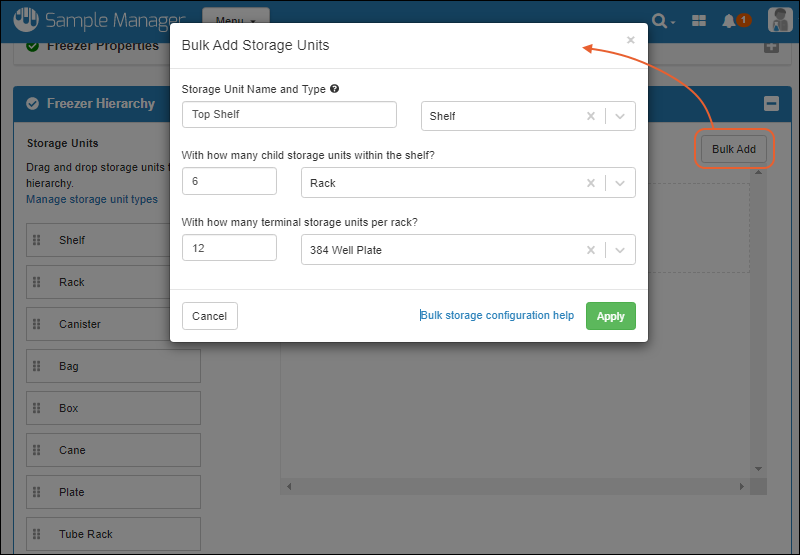
Click
Apply to complete the addition. By default, bulk units are named [unit type] #[number]. No labels are applied. You'll be able to
expand and customize the new units just as if they had been added individually.
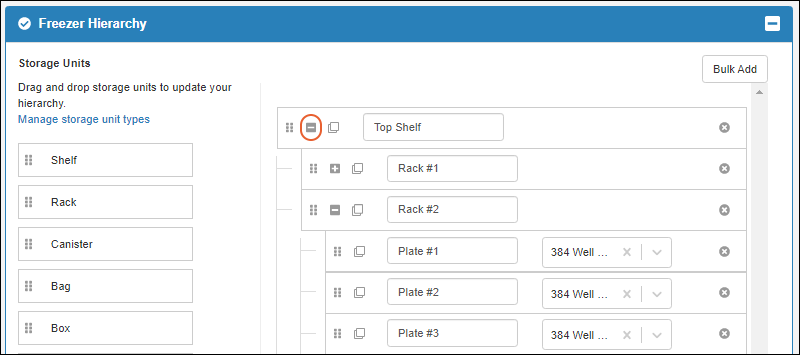
Next Steps
Once you have added at least one freezer that includes some terminal storage locations, you can proceed to
store samples in freezers.
Related Topics